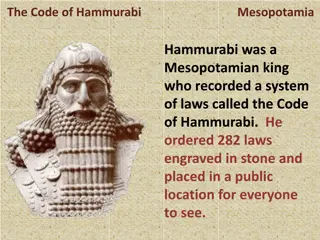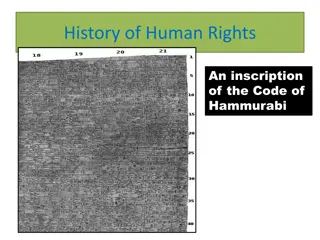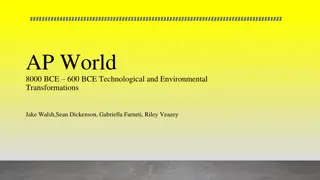The Code of Hammurabi: Ancient Laws of Mesopotamia
Hammurabi, a Mesopotamian king, established the Code of Hammurabi, a set of 282 laws inscribed in stone for public view. These laws included specific punishments for various offenses, famously epitomized by the principle of "an eye for an eye." The code encompassed both criminal and civil laws, shap
5 views • 29 slides
Understanding Hammurabi's Code: Rich vs. Poor, Men vs. Women, and Biases
Explore the ancient laws of Hammurabi's Code and their implications on social classes and gender roles. Uncover how the rich were treated differently from the poor and how men held greater rights than women under this legal system. Analyze the biases of Hammurabi, a wealthy king, and understand how
0 views • 12 slides
Ancient Origins of Human Rights: Code of Hammurabi to Cyrus the Great
Explore the historical roots of human rights, starting from the Code of Hammurabi in Mesopotamia, through the reforms of Urukagina and the Neo-Sumerian Code of Ur-Nammu, to the groundbreaking principles established by Cyrus the Great in the Achaemenid Persian Empire. Witness the evolution of human r
0 views • 27 slides
Understanding Hammurabi's Code: Rich vs. Poor, Men vs. Women, and Biases
Explore the ancient laws of Hammurabi's Code and analyze how they differentiated punishments based on social status and gender. Learn about the biases of King Hammurabi and how they influenced the legal system he established in Mesopotamia. Delve into the historical context to understand the unequal
0 views • 12 slides
Ancient Civilizations of the Fertile Crescent
Explore the geography and history of the Fertile Crescent, including Mesopotamia, Sumer, and later civilizations like Babylon. Learn about the rich farmland, nomadic lifestyle, irrigation methods, Sumerian achievements in writing, and the rise of empires under rulers like Sargon and Hammurabi.
0 views • 13 slides
Early Human Civilization: Technological and Cultural Transformations
The transition from the Neolithic Revolution to the Bronze Age marked significant advancements in agriculture, metalworking, trade, and governance. The Neolithic Revolution brought about permanent settlements and agricultural farming, while the Bronze Age introduced widespread use of bronze and econ
0 views • 7 slides
Evolution of Criminal Law and Thought: From Pre-Classical Era to Enlightenment
Explore the progression of criminal law and thought from the Pre-Classical School of Thought to the Enlightenment era. Delve into concepts like folkways, mores, and the origins of criminal law, including examples such as societal norms, dress codes, and supernatural explanations for behaviors during
0 views • 23 slides
Ancient Civilizations and Historical Figures Overview
Explore the early eras of human history, from prehistoric times and the Old Stone Age to the rise of ancient cities like Catal Huyuk. Learn about the significance of scribes, nomads, and the Paleolithic period. Delve into the realms of archeology, Neolithic advancements, polytheism, and bureaucratic
0 views • 20 slides







